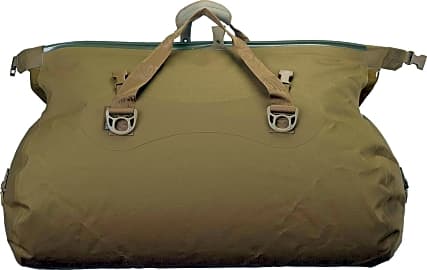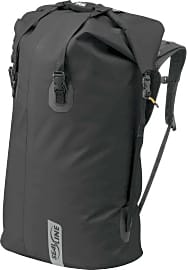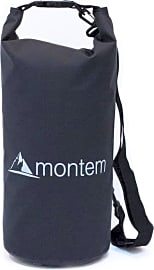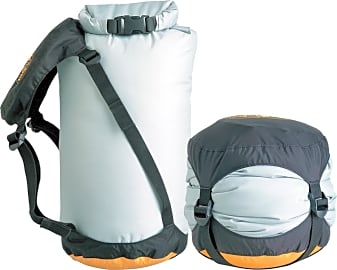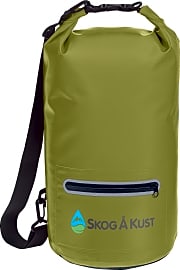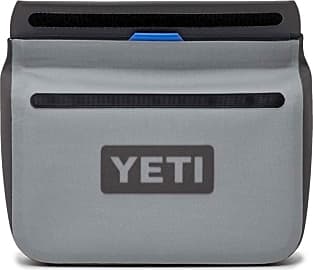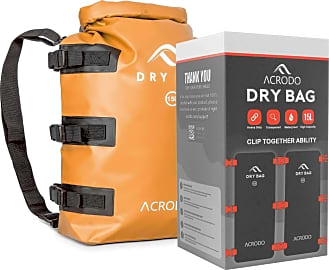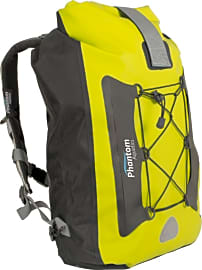The 10 Best Dry Bags

This wiki has been updated 40 times since it was first published in July of 2015. If you enjoy sailing, hiking in rainstorms, or negotiating raging rapids, you will want to protect your expensive, delicate electronics and your change of clothes on any excursion. One of these dry bags should be able to ensure nothing important gets damaged by water, and we've included a wide variety of sizes to accommodate most needs, from a quick day hike through to a more lengthy adventure. When users buy our independently chosen editorial recommendations, we may earn commissions to help fund the Wiki.
Editor's Notes
September 02, 2020:
Before we address our top choices, we'd like to note that dry bags, despite the name, come in two broad types, those that are submersible and those that are not. It can be tempting to think that fully submersible bags are always better than the latter, but these rugged bags tend to be heavier and more expensive. Broadly speaking, you can rely on the submersible type when your gear is likely to be dunked, while the rest — sometimes, but not always, called dry sacks — protect against splashes, sweat, and light precipitation.
As for entirely waterproof models, the Watershed Colorado Duffel and, for quick dunks, the SealLine Boundary Pack remain top choices. The Colorado, as you can tell from the name, is a duffel, while the Boundary Pack is a backpack, but both are made to high quality standards from rugged materials you can count on in any weather. Both are on the pricey side; we added the Acrodo Rucksack for those who need a more budget-friendly choice. We like the buckles that allow you to clip many of them together, but the straps aren't as comfortable as those you'll find on pricier options.
When it comes to models that shouldn't be submerged, the Sea to Summit Big River is still tough to beat. Most camping or hiking enthusiasts will recognize the Sea to Summit name, and this lightweight choice lives up to the company's reputation for quality. We included the Sea to Summit eVent, as well, which is a compression stuff sack that stands up to wet conditions.
April 12, 2019:
Trying to count the number of dry bags available is like trying to count the number of hairs on a human head, but we've combed through them (the bags, not the hair) to select those on which you can rely. We still think that it's hard to beat the Sea to Summit Big River and the SealLine Boundary Pack, the latter of which has been updated for an even better carrying experience with the same sleek appearance. We also added the Watershed Colorado for its similar low-key style but in a duffel format. It comes from a company that has built waterproof bags so rugged they're used by the U.S. military, so you can confidently rely on it to haul your gear no matter where you go. As you'd expect, however, it doesn't come cheap. Finally, we removed the SealLine See, due to availability problems, and the Blue Sky Basics, which simply can't hold up over the long term. Instead, we like the Yeti Hopper Sidekick, even though it does not come with a waist strap. To take advantage of its unique magnetic closure, you can provide your own strap or use a belt.
Special Honors
Patagonia Stormsurge With the Patagonia Stormsurge, no conditions are too wet or too difficult, but this ruggedness doesn't make it uncomfortable. It has an ergonomic back panel, sternum strap, and thoughtfully designed shoulder straps, all of which ensure that it's a breeze to carry no matter where you go. patagonia.com
L.L.Bean Waterproof Switchpack The L.L.Bean Waterproof Switchpack is like two bags in one, since the front pocket detaches from the backpack, and clips onto the harness system to act as a chest pack. While this pocket is only water-resistant, the main bag is totally waterproof; count on the roll-down top with sturdy buckles to keep everything inside safe and dry. llbean.com
Panga 100 Duffel It is definitely an investment, but the Panga 100 Duffel has a high-density nylon shell and Hydrolok zipper that keep moisture away from your most delicate gear, as well as a strong EVA molded bottom that can take some abuse. The bright blue interior is a nice touch, as well, that makes it easy to find what you're looking for, even in low light situations. yeti.com
The Properly Prepared Adventurer
Just as a helmet protects your head and good boots protect your ankles, a good dry bag can keep a portion of your supplies safe and dry.
The motto of the Boy Scouts of America is elegant in its simplicity: Be Prepared. This adage informs any wise and experienced outdoorsman, whether or not he (or she) was ever a scout. Proper preparation for an excursion into the wilderness, be it to climb a mountain, paddle down a river, or snowshoe across miles of frosty meadow, involves proper planning both for the expected conditions and for any changes that could arise.
The unforeseen issues that can pop up during a wilderness expedition can come in the form of changes in the weather, injury, damaged or lost gear, or a traveler team that becomes lost or stranded. Wilderness safety requires planning for all of these scenarios and more, and that means having redundancies for certain gear, it means packing first aid supplies, bringing plentiful food and water, and it means having a way to protect your supplies and rations, as well. You wouldn't go on a long hike with one pair of socks or neglect to bring spare batteries for a headlamp when spelunking, so don't neglect to protect your critical gear or food, either.
Just as a helmet protects your head and good boots protect your ankles, a good dry bag can keep a portion of your supplies safe and dry. Dry layers of clothing can mean the difference between comfort and hypothermia, and dry medicines or first aid gear can mean the difference between swift recovery from accident or illness and a seriously dangerous situation. As for dry food, that can mean the difference between creature comfort and an abjectly miserable time in the field.
Dry bags are critical for trips in personal watercraft like a kayak or canoe, and are a good idea for any adventure on the water, even in a larger boat, where waves, spray, and rain are likely. But so too is a dry bag a wise choice for the overland hiker, skier, or cyclist. When precipitation appears, be it in the form of rain, sleet, or snow, or when you accidentally fall into that stream or lake, you'll be thrilled to have those few liters worth of storage space kept nice and dry.
Choosing The Right Dry Bag
There are two basic types of dry bag: those designed to be stowed, and those meant to be worn backpack style. All dry bags have some sort of handle, strap or harness, but in many cases these are single cross-chest style slings straps that are not comfortable for long-term wear; these bags fit into the former category, and are primarily intended to be tucked away into a kayak, canoe, sailboat, or other water craft. Backpack style bags on the other hand can be worn for long periods of time in relative comfort, especially as most backpack dry bags have both shoulder and waist straps. (A pack's waist strap usually carries as much or more weight than the shoulder straps.)
Logic dictates that the longer expedition will require more supplies and thus more storage capacity.
While at first blush one might think a backpack style dry bag would always be the best choice, as it affords the chance for comfortable wearing or for stowing, this is often not the case. Backpack dry bags tend to be much bulkier than their tubular shaped counterparts, making them harder to stash in the hatch area (the storage bulkhead usually in the front) of a kayak or under a seat in a canoe. Backpack dry bags tend also to be larger even when empty and compacted for storage. However, this larger size may be imperative for carrying larger, non flexible items like camp stoves or even laptop computers.
That said, ultimately the most important factor when it comes to choosing dry bag is the volume of gear you will need to keep dry. Logic dictates that the longer expedition will require more supplies and thus more storage capacity. Most dry bags have a storage capacity of between 20 and 30 liters (most internal frame hiking packs average around 60 liters at full capacity), though some offer double and even triple that space. That means your dry bag will likely not be the only gear transport system you bring along for any trip lasting more than a single night or weekend. Make sure your dry bag works with the other bags and gear you're bringing along; it's just one part of your larger system.
A Few Words On Dry Bag Maintenance
One of the largest drawbacks to a dry bag is predicated on its very design: just as a dry bag will admirably keep water out, so to will it keep water in. If your dry bag gets wet inside, whether from a leaking water bottle, from spills or splashes that occur while it was open, or from residual water after a cleaning, it will hold that liquid in and resist drying out. That means the chance for mildew and mold growth, and neither of those are good news.
In order to keep your dry bag in good working order, you need to regularly clean its interior using anti bacterial sprays or wipes. A cleaning must always be followed by a thorough drying, including manual drying with towels and then plenty of exposure to the air. Always check your dry bag's interior and make sure it's clean before you use it, and make sure to properly clean and dry it before you store it away.



